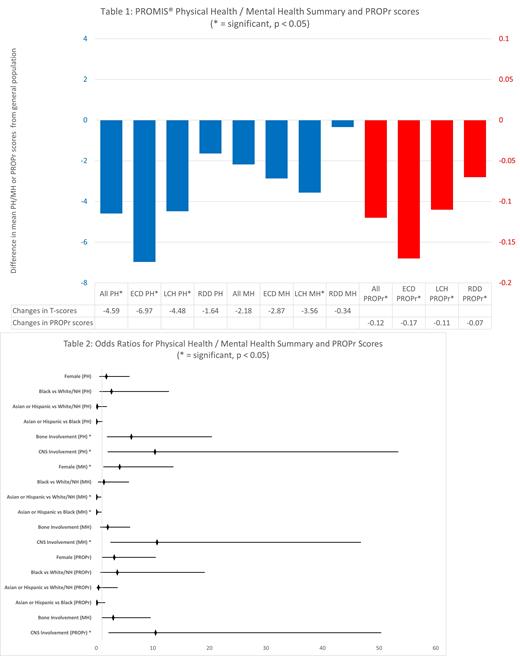Purpose: Advances in targeted therapeutics for histiocytic neoplasms have led to a growing survivor population, especially for Erdheim-Chester disease (ECD), Langerhans cell histiocytosis (LCH), and Rosai-Dorfman disease (RDD). This growing population is at risk of adverse health-related quality of life (HRQoL) as a result of the disease or treatments received. Patient-reported outcomes in this population remain understudied, and we aim to define their HRQoL using a validated tool.
Methods: We enrolled patients from 2 histiocytosis centers and an international conference from Aug 2022-April 2023 to complete the PROMIS © (Patient-Reported Outcomes [PROs] Measurement Information System) 29+2 profile v2.1, which captures 8 domains of physical/mental health and functioning. Domains are reported as T-scores, with 50 being the general population mean. We calculated summary T-scores for Physical Health (PH) and Mental Health (MH), and differences of 3 from general population were considered clinically meaningful. We then used these T-scores to calculate each patient's PROMIS-Preference (PROPr) score, which is a health-utility score that measures overall HRQoL. A mean PROPr score difference of 0.4 from the US population mean of 0.52 was considered meaningful. We ran independent-samples t-tests to examine differences in PH/MH summary scores and PROPr between sub-cohorts. Finally, we performed a multinomial logistic regression analysis to identify factors associated with worse scores, and calculated odds ratios (OR) for each factor.
Results: We included a total of 77 participants. Specific diagnoses included ECD (n=33, 42.9%), LCH (n=21, 27.3%), RDD (n=19, 24.7%), and other/unknown (n=4, 5.2%). Median age at diagnosis was 50y (9-79) and at survey was 54y (18-82), with a median 4 year difference between diagnosis and survey completion. Racial demographics included white (n=64, 83.1%), Black (n=12, 15.6%), and Asian (n=1, 1.3%). 4 patients (5.2%) identified as having a Hispanic ethnicity. Disease extent included unifocal (n=13, 16.9%), single system multifocal (ss-M, n=8, 10.4%), single system lung LCH (ss-L, n=3, 3.9%), or multisystem (n=53, 68.8%) disease. The most commonly involved organs included bone (n=44, 57.1%), kidney (n=24, 31.2%), skin (n=24, 31.2%), CNS (n=24, 31.2%), and pituitary (n=19, 24.7%). PH and MH summary scores were lower in various diagnostic categories as compared with the US population, and PROPr scores were reduced in all diagnostic categories. Bone involvement was associated with worse PH (-6.16, 95%CI -10.81, -1.52, [p=0.005]), MH (-7.96, 95%CI -12.48, -3.44, [p=<0.001]), and PROPr (-0.184, 95%CI -0.313, -0.056, [p=0.003]) scores. CNS involvement was associated with worse PH (-4.78, 95%CI -9.14, -0.42, [p=0.016]). We initially constructed a multinomial regression model using diagnosis, race, age at survey completion, and CNS and bone involvement. This model was not statistically significant, and in particular, diagnosis and age did not significantly contribute to the model. We then removed diagnosis and age and constructed a new model using the remaining variables, which was statistically significant for all 3 scores (p<0.05). We found that factors associated with worse PH score were disease involvement of bone (OR=6.19, 95%CI 1.88, 20.43 [p=0.003]) and CNS (OR=10.36, 95%CI 2.01, 53.39 [p=0.005] Figure 2). Factors associated with worse MH scores included female sex (OR=4.12, 95%CI 1.24, 13.66 [p=0.021]) and CNS involvement (OR=10.74, 95%CI 2.47, 46.79 [p=0.002]). Having race/ethnic group other than white/Non-Hispanic or Black was associated with improved MH. However, as this group had only 4 members, the significance of this is uncertain. Finally, CNS involvement was found to be associated with worse odds of having a low PROPr score (OR=10.46, 95%CI 2.17, 50.37 [p=0.003]).
Conclusions: Several PROs were worse in patients with histiocytic neoplasms as compared with the general population. We further found that CNS involvement was independently associated with worse HRQoL, regardless of the diagnosis type. Additionally, female sex was associated with worse MH scores, and bone involvement with worse PH scores. PROPr score was particularly low among patients with ECD. Future research is warranted to assess the impact of treatments on HRQoL, as well as the economic loss resulting from loss of productivity as highlighted by low PROPr scores.
Disclosures
D'Souza:Imbrium, Pfizer, Bristol Myers Squibb: Membership on an entity's Board of Directors or advisory committees; Janssen, Prothena: Consultancy; Abbvie, Sanofi, Takeda, TeneoBio, Caelum, Prothena: Research Funding. Goyal:Opna Bio: Membership on an entity's Board of Directors or advisory committees.


This feature is available to Subscribers Only
Sign In or Create an Account Close Modal